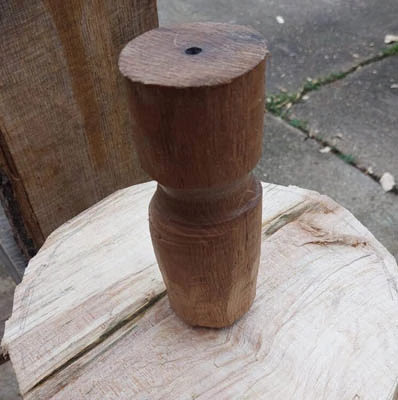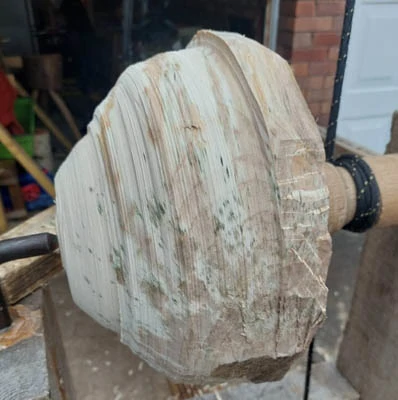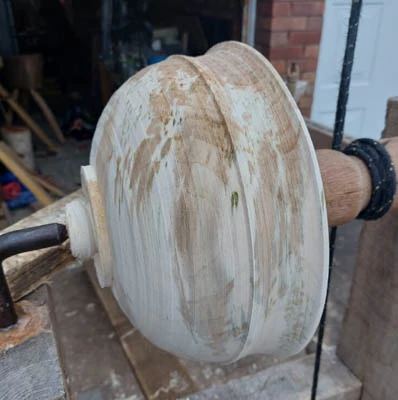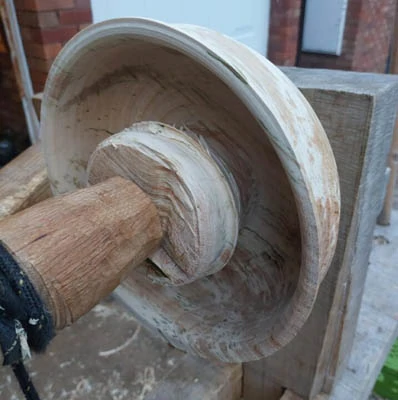
Greenwood working, an age-old tradition, is crafting greenwood into beautiful, functional objects. At the heart of this tradition is the pole-lathe, a unique tool that’s been the cornerstone of many greenwood crafts, including the mesmerising art of bowl turning. This article delves into the basics of greenwood and the enchanting world of pole-lathe bowl turning and related heritage crafts.
What is Greenwood?
Greenwood is unseasoned or fresh wood, usually sourced directly from trees or logs recently felled. As opposed to seasoned or dried wood, greenwood is softer, making it easier to shape, carve, and turn. Greenwood working celebrates the natural characteristics of wood, such as colour variations, grain patterns, and inherent strength.
Pole-lathe: A Historical Overview
A pole-lathe, traditionally used in greenwood working, is a foot-operated lathe that harnesses the springiness of a bent pole to provide the turning motion. Originating from medieval times, this lathe has remained a favourite among artisans for its simplicity and efficiency.
Construction and Operation:
A typical pole-lathe comprises a sturdy horizontal bed with two moveable poppets that are secured using wooden wedges. The workpiece, in this case, a greenwood blank destined to become a bowl, is held between the two poppets. Above the lathe, a flexible pole is anchored, and a cord from this pole is wrapped around the workpiece. Some pole-lathe turns, myself included, use a bungee cord as a modern-day replacement for the pole. By pressing down on a foot treadle, the craftsman turns the workpiece. Releasing the treadle allows the pole’s elasticity to return the workpiece to its original position, readying it for another turn. Check out my blog on how to build a pole-lathe.
Pole-lathe Bowl Turning
1. Preparing the Blank:
The process begins by preparing a greenwood blank. This involves splitting a log and roughly shaping it into a circular shape reminiscent of a bowl.
2. Mounting and Turning:
The Blank is then mounted on the pole-lathe. As the bowl-turner operates the treadle, they use specialist hook tools to remove waste wood and turn the blank into a bowl. I find bowl-turning relaxing and offers an escape from daily worries.
3. Finishing:
All greenwood items must be dried slowly, and bowls are no exception. This can take a few days to a few weeks, depending on the temperature where the bowl is stored and how large the bowl is. Once dry, there are a few options (there are more) for finishing and protecting the bowl’s surface:
- Drying oils
Oiling a wooden bowl helps to improve its appearance. It highlights the natural beauty of the wood and its grain. I use food-grade walnut oil or tung oil. Both are what’s known as polymerising oils or drying oils. This is important as non-drying oils such as olive oil may go rancid if used as a finishing oil.
- Milk Paint
Milk paint is a type of paint made from milk protein, lime, and natural pigments. It’s known for its eco-friendly properties and matte finish. Unlike many modern paints, it doesn’t contain harmful chemicals or volatile organic compounds (VOCs). This makes it a safer choice for both the environment and users.
- Raw or Uncoated
The previous suggestions help to protect a wooden bowl and improve its appearance. However, it’s not an actual requirement. Wood has a natural anti-bacterial property that keeps wooden utensils safe to use as tableware. But if you want to preserve its appearance, I recommend oiling your bowl as a minimum.
Related Greenwood Crafts
While bowl turning is a highlight, greenwood working encompasses a range of crafts:
- Spoon Carving: This involves using special knives and gouges to carve spoons from greenwood blanks.
- Chair Making: Traditional chairs, especially the Windsor style, have been crafted using greenwood techniques.
- Rustic Furniture: Greenwood is ideal for crafting rustic benches, stools, and tables.
- Tool Making: Craftsmen often fashion their tools, like mallets, from greenwood.
Conclusion
Green wood working, with its reliance on age-old techniques and tools, is a testament to humanity’s enduring relationship with nature. The pole-lathe, as a symbol of this tradition, brings to life the beauty and functionality of wood. Whether you’re a craftsman, an admirer, or someone seeking to learn, the world of greenwood, especially the art of bowl turning, offers a journey back to our roots and a tactile connection to the world around us.
Benefits of Learning a Craft Like Bowl Turning
Embracing an ancient craft like bowl turning offers numerous benefits that touch upon personal, communal, and environmental aspects. Let’s delve deeper into why learning and practising this craft is not just about creating tangible objects but also about forging a deeper connection with oneself and the environment.
1. Personal Growth and Fulfillment
- Skill Development: As with any craft, learning bowl turning hones fine motor skills, precision, and patience. Turning a raw piece of wood into a beautifully shaped bowl is intricate and requires a gradual build-up of skill.
- Therapeutic Benefits: Many enthusiasts find the rhythm of the pole-lathe and the tactile nature of wood to be meditative. Working with hands, focusing on the wood grain, and shaping a piece brings a sense of tranquillity and mindfulness.
- Achievement and Pride: Completing a bowl or any crafted piece provides a sense of accomplishment. There’s an unparalleled satisfaction in creating something tangible from scratch.
2. Cultural and Historical Appreciation
- Connection to Ancestry: Engaging in bowl turning directly links ancient practices and traditions. It offers a unique way to understand and appreciate the craftsmanship of our ancestors.
- Preservation of Craft: In an age dominated by mass-produced goods, keeping traditional crafts alive ensures they’re preserved in history. Each bowl turned, and each new craftsperson trained adds to this legacy.
3. Community Engagement
- Shared Learning: Joining a community of greenwood workers, such as the Burwash Bodgers in Cambridge, where I am a member. Or you can find your local group by visiting Bodgers.org.uk.
- Collaboration: Greenwood crafts often lead to collaborative projects, from community fairs to group workshops, fostering a sense of belonging and unity.
4. Environmental Mindfulness
- Sustainable Crafting: Greenwood working, especially with locally sourced greenwood, promotes sustainability. Artisans often use every part of the wood, minimising waste.
- Reconnecting with Nature: Working with wood, understanding its grains, and appreciating its natural beauty fosters a deeper connection with nature. It serves as a reminder of the environment’s importance and the need to protect it.
- Reduced Carbon Footprint: Traditional pole-lathes are foot-powered, negating the need for electricity. This reduction in energy consumption contributes to a smaller carbon footprint.
5. Economic Opportunities
- Entrepreneurial Ventures: For those who master the craft, there’s potential to turn it into a business. Given their unique nature, hand-turned bowls are sought by people looking for unique gifts.
- Teaching Greenwood Workshops: As interest in traditional crafts grows, there’s a demand for workshops and courses. Skilled artisans can offer classes, sharing their knowledge and passion with others.
Conclusion
In essence, learning a craft like bowl turning is a multifaceted experience. It’s not just about the end product but about the journey — a journey of personal growth, community engagement, and environmental consciousness. As the world becomes more digitised and automated, such crafts remind us of the irreplaceable value of human touch, creativity, and connection to our roots.






